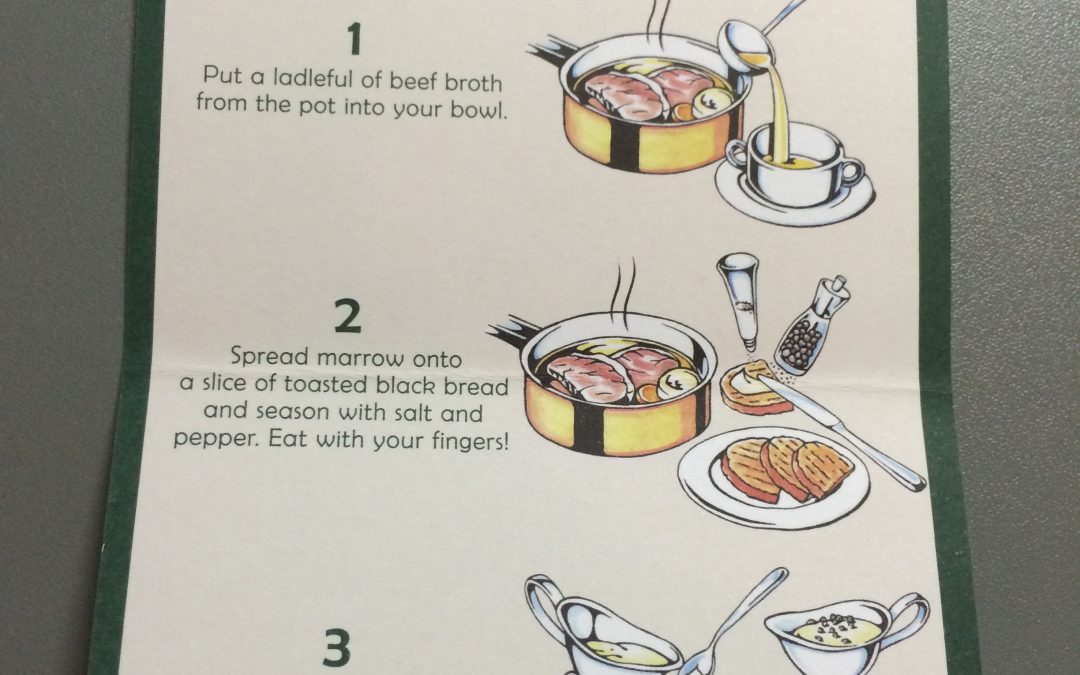Vienna was bookended by two fabulous meals. The first night we ate tafelspitz at Plachutta’s restaurant. This is a dinner of boiled meat served with horseradish. For our version, the meal came to the table in the pot. First you ladle out a bowl of the broth and crispy vegetables, accompanied by the marrow that you scrape from the bones in the pot and spread on black bread. Then you remove the meat from the pot, the cut chosen by the customer from a diagram of the cow on the menu. There is also a pot of potatoes and this is accompanied with chive cream and horseradished applesauce for the meat. We shared one meal and still had leftovers.
We also made an afternoon jaunt to the Sacher Hotel to have the “original” sacher torte. We did, however, resist the menu at one restaurant that included Altwiener Kaiserschmarrn, translated on the menu as “Old Viennese Rubbish with homemade stewed apricots.”
It was such a relief to find that the churches in Vienna venerate the saints and not the archbishops as in Salzburg. Perhaps all archbishops were saints in past centuries? Even if I believed that, it was disconcerting to see archbishops staring out from the side altars rather than saints. The wealth of the Church always overwhelms me, but the wealth of the archbishops in Salzburg seemed to be a special case. They lived like royalty, even ruling the town openly like little kings.
We made side trips to Budapest and Prague. Usually we prefer to be in a city for a time to “feel” the city. This time we popped in and out, assuming we might not have another chance to visit these cities, something I hope we don’t do again. There was more travel time than touring time. It also made us think that our reluctance to go on organized tours might be justified. “In just a few minutes,” the tour guide says, from the front of the bus, “we will pass a beautiful church, built in the [fill in the blank] century. Get your cameras ready. Okay, now! Snap a picture!” And the bus never slows down.
 |
| Old Budapest |
 |
| Historic Prague |
One of the highlights of Vienna was touring the opera house. There are tickets priced for everyone and individual translators at every seat. The tickets range in price from 150 euros down to a few euros for a standing-room-only ticket the day of the performance. One traveler we met said that he had paid three euros for a place in the standing balcony. “There are rails,” he said, “so you don’t feel like you’re off-balance or anything.” Or you can choose to watch the opera for free. A giant screen outside the opera house broadcasts the performance inside.
 |
| Outdoor Screen at Opera House |
 |
| Individual Translators at Opera Seats |
I was struck by the fact that the opera company assures that all citizens have an opportunity to attend, regardless of ability to pay. But then, this is not surprising when you learn that the opera house was one of the first buildings rebuilt after the bombings by the allies during World War II destroyed so much of the city.
I did find it amusing that the citizens protested loudly about how modern the building was when it was rebuilt. In my mind I compared it to the Palau de la Musica in Barcelona that we visited last year, and I chuckled.
 |
| Grand Entry at Vienna Opera House |
 |
| Grand Entry at Palau de la Musica in Barcelona |
For me, this trip instilled a fascination with Maria Theresa, the only Habsburg woman to rule in the three centuries the dynasty was in power. She ruled for forty years, fighting wars while promoting commerce. In addition she gave birth to sixteen children, thirteen of them surviving beyond infancy. She used her daughters to form alliances with other realms, the most famous perhaps being the marriage of Maria Antonia (re-named Marie Antoinette by the French). She did play favorites, however. She preferred Maria Christina and allowed her to marry the man she loved, although even she married well.
Vienna is a city of musicians. It was a magnet for Mozart, Johann Strauss, Beethoven, Haydn, Schubert, Wagner, Brahms and Schöenberg, to name but a few. Even my beloved Vivaldi came here to find fame and fortune. Unfortunately, he found neither and died here a pauper. Because my book on Vivaldi does not include his death I had not planned to do any research here, but the universe provides. While walking around one day we found a plaque marking the place where he had lived.
The night before we flew home, we went to Grieschenbeisl, a restaurant that has been on the same spot since 1447. It is a place that has always attracted artists and politicians. On one wall you can find signatures written by Wagner, Beethoven, Mozart, Mark Twain and Johnny Cash. For some reason, we wound up in a room where every table, except for ours and one other, was filled with women, in twos, threes, fours, even singles. I’m not sure why we are placed there but I felt very comfortable. We ordered wiener schnitzel. When I gasped at the size, one of the women dining alone tittered at my response. The plates were huge and we should have shared as we did with the Tafelspitz. Now we are home, savoring memories as we did the food.
 |
| Sentinel for the General’s Belvedere in Vienna |




